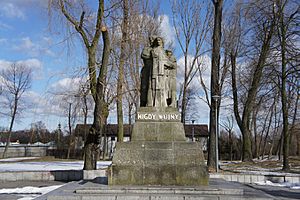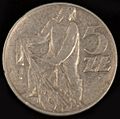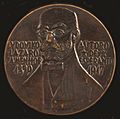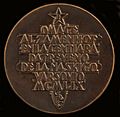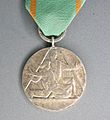Józef Gosławski (sculptor) facts for kids
Quick facts for kids
Józef Gosławski
|
|
|---|---|
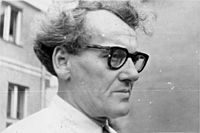 |
|
| Born |
Józef Jan Gosławski
24 April 1908 Polanówka, Congress Poland, Russian Empire
|
| Died | 23 January 1963 (aged 54) |
| Nationality | Polish |
|
Notable work
|
Frédéric Chopin monument in Żelazowa Wola, "Never war" monument, The Music in Warsaw, Adam Mickiewicz monument in Gorzów Wielkopolski, Józef Piłsudski monument in Turek, Medal of the 10th-Anniversary of People's Poland, Medal for Sacrifice and Courage |
| Awards | |
Józef Jan Gosławski (born April 24, 1908 – died January 23, 1963) was a famous Polish artist. He was a sculptor, meaning he created art by shaping materials like clay or stone. He was also a "medallic artist," which means he designed medals and coins.
Gosławski created many important works. These include large statues like the Chopin monument in Żelazowa Wola. He also designed coins, such as the 5 zł coin with a fisherman. His medals, like the one called Year 1939, are also well-known. He won many art competitions and received the Silver Cross of Merit award.
Contents
Józef Gosławski's Life Story
Józef Gosławski was born in a village called Polanówka in Poland. He grew up in Wąwolnica with his parents, two brothers, and two sisters. His younger brother, Stanisław Gosławski, also became a sculptor.
Józef started his art education at a special school in Kazimierz Dolny. He later wanted to study at the Academy of Fine Arts in Kraków. He was too young at first, so he went to another art school in Kraków.
In 1932, he finally began studying at the Academy of Fine Arts in Kraków. He learned from famous professors like Xawery Dunikowski and Tadeusz Breyer. He then received a scholarship to study in Rome, Italy. He graduated from the Royal Academy of Fine Arts in Rome in 1937. While in Italy, he joined a group of Polish artists called The Capitol. He was even the group's vice chairman.
Józef returned to Poland in July 1939. He was supposed to work on restoring the Royal Castle in Warsaw. However, World War II started soon after, so he couldn't take the job. He spent the war years in Wąwolnica. After the war, he helped fix old buildings, like a 17th-century house in Kazimierz Dolny.
From 1947, he taught at the National Artistic School in Poznań. He also led the Poznań branch of the Association of Polish Artists and Designers (ZPAP) for several years. In 1948, he married Wanda Mankin, who was one of his students. They had two daughters, Bożena and Maria. In 1956, his family moved to Warsaw. Józef became a leader in the ZPAP's sculpture department. He passed away suddenly in Warsaw in 1963.
Józef Gosławski's Artworks
Józef Gosławski created many different kinds of art. He made monuments (large statues), portraits (sculptures of people's faces), funny caricatures, medals, and coins. He also helped restore old buildings and made drawings.
His early works showed some influence from cubism, an art style that uses geometric shapes. He was also inspired by other Polish artists. When he studied in Italy, he was influenced by ancient Roman and Italian Renaissance art. Many of his artworks from before the war were lost when they were being shipped back to Poland in 1939.
During World War II, he focused on smaller art pieces, especially medals. These medals often showed the suffering of the Polish people during the war.
After the war, he became very important in the world of medal art. He was known for trying new ideas and moving away from traditional medal designs. His medals are now in many museums in Poland and other European countries like Prague, Rome, and Paris.
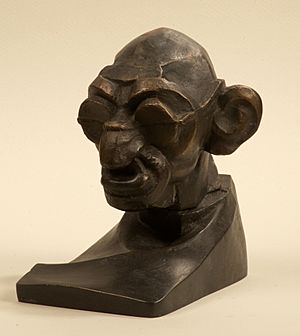
Gosławski also returned to making large sculptures. Some of his famous monuments include the Adam Mickiewicz monument in Gorzów Wielkopolski. He also created the Never war monument in Żabikowo and a sculpture group called Music in Warsaw. His most famous work is the Frédéric Chopin monument in Żelazowa Wola. He won many contests for his monument designs.
Józef Gosławski's art is hard to put into one category because he was always trying new things. But his main focus was always people, whether they were heroes or just everyday individuals. He was known for being kind and friendly. Even his caricatures, which are rare for sculptors, were gentle and funny, not mean.
He had 14 solo art shows, and his works were shown in over 60 exhibitions in Poland and more than 20 abroad.
Winning Art Competitions
Józef Gosławski often entered art competitions and won many awards. Here are some of his notable wins:
| Year | What the Competition Was About | What Happened |
|---|---|---|
| 1936 | Bust (head and shoulders sculpture) of Józef Piłsudski | First prize! The sculpture is now in the National Museum, Warsaw. |
| 1946/47 | Design for the Polish national emblem | Second prize. |
| 1951 | Sculptures for Constitution Square, Warsaw | He designed three large sculpture groups, including Music in Warsaw. |
| 1951 | Design for a special badge | First prize. |
| 1951 | Design for a State Award medal | First prize. |
| 1958 | Designs for new Polish coins | He won first prize for a 10 złotych coin with Mieszko and Dobrawa. He also designed the 5 zł coin with a fisherman, which was used in 1958. |
| 1958 | Monument of Heroes of Warsaw | He won a prize for his first design. |
| 1959 | Monument of Heroes of Warsaw (second stage) | He won first prize (one of six winners). He worked with his wife Wanda and brother Stanisław on this design. |
Solo Art Shows
Józef Gosławski had many exhibitions where only his art was shown. Here are some of them:
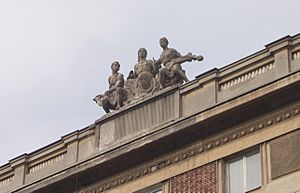
| Year | City | Place |
|---|---|---|
| 1933 | Kraków | Palace of Arts |
| 1960 | Budapest | Polish Culture Center |
| 1963 | Warsaw | Polish Army House |
| 1968 | Wrocław | Townhall |
| 1973 | Warszawa | Central Bureau of Artistic Exhibitions |
| 1974 | Warszawa | Military Gallery DWP |
| 1974 | Warka | Kazimierz Pułaski Museum |
| 1974 | Bydgoszcz | Regional Museum |
| 1987 | Lublin | Regional Museum |
| 1995 | Kazimierz Dolny | Vistula Museum - Summer Gallery |
| 1996 | Bolesławiec | Bolesławiec Culture Center |
| 1997 | Chełmno | Regional Museum |
| 2000 | Konin | Regional Museum |
| 2003 | Warszawa | Artist's House Gallery |
| 2014 | Orońsko | Polish Sculpture Center |
| 2014/2015 | Warsaw | Sculpture Museum in Rabbitery |
Group Art Shows
Józef Gosławski's art was also part of many group exhibitions, both in Poland and other countries.
In Poland
| Year | City | Exhibition Name |
|---|---|---|
| 1946 | Lublin | The Festival of Arts |
| 1947 | Kraków | The II Nationwide Winter Salon |
| 1949 | Warszawa | Artists in the struggle for peace |
| 1950 | Warszawa | The I Nationwide Exhibition of Plastic Arts |
| 1951/1952 | Warszawa | The II Nationwide Exhibition of Plastic Arts |
| 1953 | Warszawa | 10 years of People's Army of Poland |
| 1954 | Warszawa | The IV Nationwide exhibition of Plastic Arts |
| 1958/1959 | Warszawa | The Warsaw Sculpture 1945–1958 |
| 1959 | Warszawa | Warsaw in contemporary art |
| 1960 | Warszawa | The Polish Sculpture 1945–1960 |
| 1963 | Warszawa | The I Nationwide Exhibition of Medallic Art |
| 1963 | Warszawa | Warsaw in Art |
| 1966 | Wrocław | Medallic art in People's Poland 1945–1965 |
| 1969 | Warszawa | 25-anniversary of medallic art in Poland |
| 1971 | Wrocław | Monuments and monumental sculpture in People's Republic of Poland |
| 1971 | Toruń | Nicolaus Copernicus's topic in medallic art and numismatics |
| 1979 | Wrocław | Contemporary Polish medallic art 1944–1979 |
| 1997 | Warszawa | Tadeusz Breyer and his students |
| 2003 | Warszawa | Polish science in medallic art |
| 2009 | Toruń | Nicolaus Copernicus in medallic art |
Outside Poland
| Year | Country | City | Exhibition Name |
|---|---|---|---|
| 1932 | Vienna | The International Exhibition of Caricatures | |
| 1936 | Rome | The Exhibition of Association of Artists - "The Capitol" | |
| 1950 | Prague | The World Exhibition of Medallic Art | |
| 1959 | Vienna | The International Exhibition of Contemporary Medals | |
| 1965 | Berlin-Erfurt-Leipzig | The soldiers of the nation - the Polish army in the art | |
| 1966 | Sofia | The exhibition of Polish medallic art | |
| 1967 | Paris | The XXVII Salon of The Sacred Art | |
| 1971 | Paris | The 50 years of the medallic art in Poland | |
| 1971 | The Hague | The exhibition of Polish medals | |
| 2003 | Vienna | The New State. Polish Art between Experiment and Representation 1918–1939 |
Józef Gosławski's Legacy
Józef Gosławski's work is still remembered today. For example, in 2008, the Polish Mint (the place where coins are made) created a special coin for Lidzbark Warmiński. This coin was based on one of Gosławski's medals.
In 2009, the Polish Mint also made a series of medals called Famous Medallists. One of these medals was dedicated to Józef Gosławski. It included a design he made during World War II, called Year 1939, which had never been shown to the public before. Another medal in the series showed Gosławski's face on one side and his Chopin monument on the other.
Also in 2009, silver and gold copies were made of his famous 5 zł coin with the fisherman design. There is even a street named after Józef Gosławski in Wąwolnica, the village where he lived and worked for many years.
Images for kids
-
Monument on the tombstone of Janina Gałowa, Rakowicki Cemetery in Cracow (1932)
-
Monument of Adam Mickiewicz in Gorzów Wielkopolski (1956)
-
Front side of a medal with Ludovic Lazarus Zamenhof (1959)
-
Back side of a medal with Ludovic Lazarus Zamenhof (1959)
See also
 In Spanish: Józef Gosławski para niños
In Spanish: Józef Gosławski para niños



